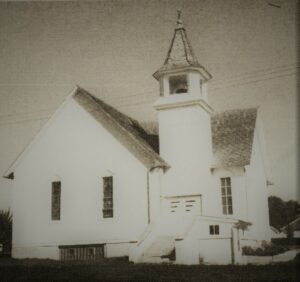
Melankton Church in Upham Photo UDJ
Melankton Congregation: During the first years of Icelandic settlement, pioneers gathered together on Sundays in each other´s homes to hear the reading from the Bible and Icelandic religious books. The service ended with the singing of Icelandic hymns. In Mouse River, North Dakota, the settlement gradually grew so that private homes no longer could be used for such religious gatherings. It was clear that the number of settlers and their families warranted the founding of a new congregation and the construction of a community hall. Jón Filippusson from Skagafjordur volunteered to go east to Pembina County for a meeting with Rev. Jónas Sigurðsson, in order to find out how this should happen. Rev. Jónas served the Icelandic communities in Pembina County and visited the settlers in the Mouse River settlement on July 21, 1897 as an advisor in forming the new congregation. He conducted an Icelandic service in a schoolhouse following which a general meeting was called. There he explained and helped organize the new congregation and he gave it the name Melankton Lutheran. Einar Westford donated some land for the construction of a new community hall which normally was called Félagshús-Icelandic Hall. The hall was used for various gatherings for several years. The Women’s association bought an organ and gave it to the hall with the stipulation that an organist be hired by the congregation and paid his salary. The population in the community kept growing, a need for a church became apparent. The Upham village was an ideal location and the interest of building a church there was great. A special committee was established which was to look for a good location in the village as well as work out an estimated cost of the construction. Everything depended on a good crop on which every farmer based his income and around 1910 and the next few years were good so the optimism was high. But the first World War as well as increase in the cost of construction material resulted in postponement. The newly established church council decided that devotions would be held on Sundays in an 18 by 30-foot log cabin and this was used until 1920s. In 1921 a new committee was appointed to find out if the Methodist Church building in Upham, N. Dakota could be purchased. After a few years of negotiations a deal was made and on October 29, 1924 the deal was done.
English version by Thor Group.
